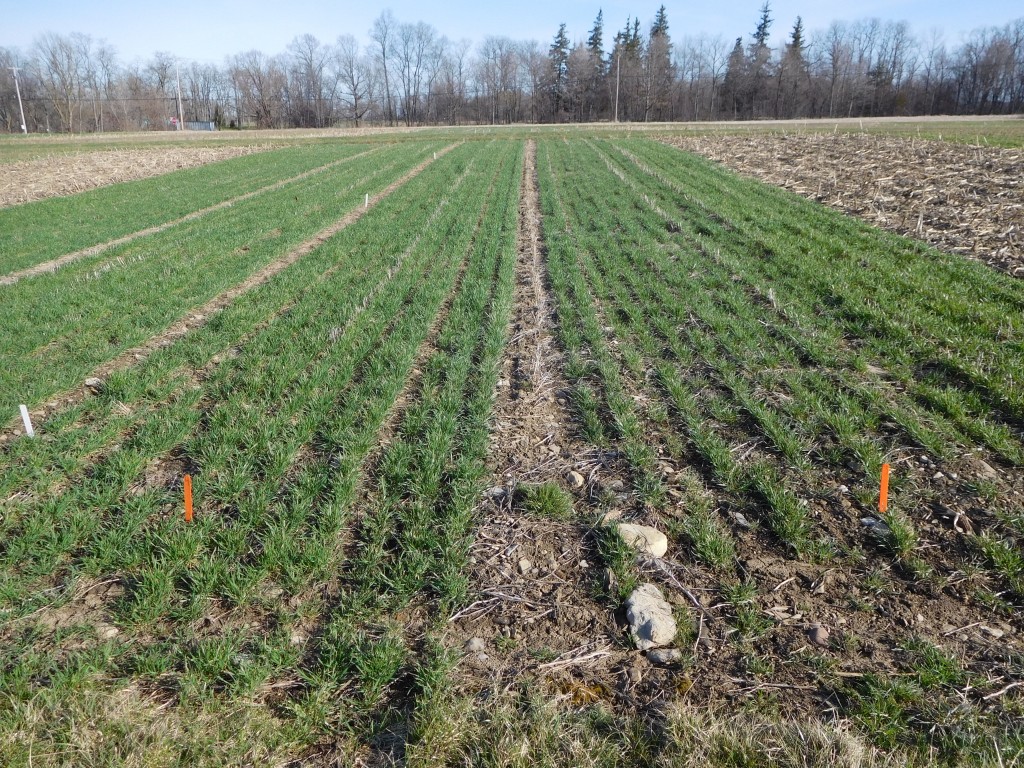Bill Cox1 and Eric Sandsted1
1Soil and Crop Sciences Section – School of Integrated Plant Science, Cornell University

We initiated a 3-year study at the Aurora Research Farm in 2015 to compare the corn, soybean, and wheat/red clover rotation in different sequences under conventional and organic cropping systems during the 3-year transition period (2015-2017) to an organic cropping system. This article will discuss weed densities determined in early spring (March 31, about 2 weeks after green-up) at the tillering stage (GS 2-3 stage) in conventional and organic wheat, the second year crop if soybean is the first year transition crop (soybean-wheat/red clover-corn rotation), under high and recommended management inputs.
We provided the management inputs for wheat in both cropping systems under high and recommended input treatments (https://blogs.cornell.edu/whatscroppingup/2015/11/23/wheat-emergence-early-plant-populations-and-weed-densities-following-soybeans-in-conventional-and-organic-cropping-systems/), but we will briefly review them. We used a John Deere 1590 No-Till Grain Drill to plant a treated (insecticide/fungicide seed treatment) Pioneer soft red wheat variety, 25R46, in the conventional cropping system; and an untreated 25R46, in the organic cropping system on 9/24 at two seeding rates, ~1.2 million seeds/acre (recommended management treatment for a September planting date) and ~1.6 million seeds/acre (high input treatment). The wheat was no-tilled in both cropping systems because of the paucity of visible weeds after soybean harvest (9/23). We also applied Harmony Extra (~0.75 oz/acre on 11/5) to the high input conventional treatment at the tiller initiation stage (GS 2 ) for control of winter annuals (chickweed, henbit, and common mallow) and winter perennials (dandelion).

We previously reported that we walked along the entire wheat plot (~100 feet X 10 feet) to count all the weeds on 11/03 at tiller initiation, prior to the Harmony Extra application to the high input conventional wheat plots (https://blogs.cornell.edu/whatscroppingup/2015/11/23/wheat-emergence-early-plant-populations-and-weed-densities-following-soybeans-in-conventional-and-organic-cropping-systems/). We were very surprised that there were fewer weeds in no-till organic wheat (0.02 weeds/m2) compared with no-till conventional wheat (0.12 weeds/m2, Fig.1). Management inputs did not affect fall weed counts. Most of the weeds were dandelion with some common mallow and chickweed also observed. We speculated that the last cultivation of soybean on July 16 removed existing or late-emerging dandelions or mallow, whereas the observed weeds in the conventional wheat may have emerged after the June 26 Roundup application to conventional soybean.
Early spring weed densities were taken on 03/31, about 2 weeks after green-up, again by counting all the weeds along the entire length of the plots. As in the fall, we found very few weeds in no-till organic wheat, 0.04 weeds/m2 in recommended and 0.05 weeds/m2 in the high-input management treatments (Fig.2). Clearly, seeding rates (1.2M seeds/acre in recommended and 1.6M seeds/acre in high input management) did not affect early spring weed densities in no-till organic wheat.

Weed densities were virtually non-existent in the high input conventional management treatment (0.01 weeds/m2), attesting to the efficacy of a timely fall application of Harmony Extra (Fig.2). In contrast, 0.46 weeds/m2 were counted in the recommended management treatment. Most of the weeds were winter annuals, including henbit, chick weed, and common mallow. We are not sure if 0.46 weeds/m2 are of sufficient magnitude to reduce yields. Nevertheless, we will not apply an herbicide to conventional wheat under recommended management because we inter-seeded red clover in early March, which reduces herbicide options.
In conclusion, no-till organic wheat and conventional wheat (with a fall Harmony Extra application) had very low weed densities at the end of March, 2 weeks after green-up. Organic wheat in the recommended and high input management treatments had similar weed densities, indicating that recommended seeding and N rates were just as effective as high seeding and N rates for weed control at the GS 2-3 stage. Conventional wheat, which did not receive an herbicide application, had 10 times the number of early-spring weeds compared with organic wheat. We are not sure why there were greater weed densities in conventional wheat, which did not receive a fall herbicide application, compared with organic wheat. Again, perhaps a July 16 cultivation in organic soybean compared with a June 26 Roundup application in conventional soybean may have influenced weed densities in the subsequent wheat crop. On April 1, organic wheat looked as good, if not better, than conventional wheat (picture). It remains to be seen, however, if Kreher’s composted chicken manure, the N source for organic wheat (60 lbs/acre of actual N pre-plant +75 lbs/acre of actual N on 3/17 in high input and the single 75 lbs/acre of actual N as a spring application in recommended management) can provide enough available N for maximum yield in organic wheat.

